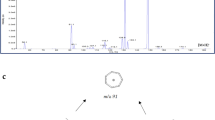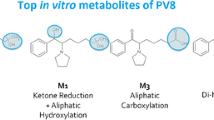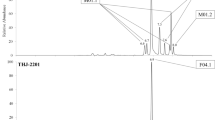Abstract
Desomorphine is an opioid misused as “crocodile”, a cheaper alternative to heroin. It is a crude synthesis product homemade from codeine with toxic byproducts. The aim of the present work was to investigate the metabolic fate of desomorphine in vivo using rat urine and in vitro using pooled human liver microsomes and cytosol as well as human liver cell lines (HepG2 and HepaRG) by Orbitrap-based liquid chromatography-high resolution-tandem mass spectrometry or hydrophilic interaction liquid chromatography. According to the identified metabolites, the following metabolic steps could be proposed: N-demethylation, hydroxylation at various positions, N-oxidation, glucuronidation, and sulfation. The cytochrome P450 (CYP) initial activity screening revealed CYP3A4 to be the only CYP involved in all phase I steps. UDP-glucuronyltransferase (UGT) initial activity screening showed that UGT1A1, UGT1A8, UGT1A9, UGT1A10, UGT2B4, UGT2B7, UGT2B15, and UGT2B17 formed desomorphine glucuronide. Among the tested in vitro models, HepaRG cells were identified to be the most suitable tool for prediction of human hepatic phase I and II metabolism of drugs of abuse. Finally, desomorphine (crocodile) consumption should be detectable by all standard urine screening approaches mainly via the parent compound and/or its glucuronide assuming similar kinetics in rats and humans.






Similar content being viewed by others
References
Katselou M, Papoutsis I, Nikolaou P, Spiliopoulou C, Athanaselis S. A “krokodil” emerges from the murky waters of addiction. Abuse trends of an old drug. Life Sci. 2014;102:81–7.
Gahr M, Freudenmann RW, Hiemke C, Gunst IM, Connemann BJ, Schonfeldt-Lecuona C. Desomorphine goes “crocodile”. J Addict Dis. 2012;31:407–12.
Rech MA, Donahey E, Cappiello Dziedzic JM, Oh L, Greenhalgh E. New drugs of abuse. Pharmacotherapy. 2015;35:189–97.
United Nations Office on Drugs and Crime (UNODC) (2015) World Drug Report 2015. https://www.unodc.org/documents/wdr2015/World_Drug_Report_2015.pdf.
Grund JP, Latypov A, Harris M. Breaking worse: the emergence of krokodil and excessive injuries among people who inject drugs in Eurasia. Int J Drug Policy. 2013;24:265–74.
Savchuk SA, Barsegyan SS, Barsegyan IB, Kolosov GM. Chromatographic study of expert and biological samples containing desomorphine. J Anal Chem. 2008;63:361–70.
Meyer MR, Lindauer C, Maurer HH. Dimethocaine, a synthetic cocaine derivative: studies on its in vitro metabolism catalyzed by P450s and NAT2. Toxicol Lett. 2014;225:139–46.
Wissenbach DK, Meyer MR, Remane D, Philipp AA, Weber AA, Maurer HH. Drugs of abuse screening in urine as part of a metabolite-based LC-MS(n) screening concept. Anal Bioanal Chem. 2011;400:3481–9.
Helfer AG, Michely JA, Weber AA, Meyer MR, Maurer HH. Orbitrap technology for comprehensive metabolite-based liquid chromatographic-high resolution-tandem mass spectrometric urine drug screening—exemplified for cardiovascular drugs. Anal Chim Acta. 2015;891:221–33.
Maurer HH, Pfleger K, Weber AA. Mass spectral library of drugs, poisons, pesticides, pollutants and their metabolites. Weinheim: Wiley-VCH; 2016.
Meyer MR, Lindauer C, Welter J, Maurer HH. Dimethocaine, a synthetic cocaine derivative: studies on its in vivo metabolism and its detectability in urine by LC-HR-MSn and GC-MS using a rat model. Anal Bioanal Chem. 2014;406:1845–54.
Wissenbach DK, Meyer MR, Remane D, Weber AA, Maurer HH. Development of the first metabolite-based LC-MSn urine drug screening procedure—exemplified for antidepressants. Anal Bioanal Chem. 2011;400:79–88.
Welter J, Kavanagh P, Meyer MR, Maurer HH. Benzofuran analogues of amphetamine and methamphetamine: studies on the metabolism and toxicological analysis of 5-APB and 5-MAPB in urine and plasma using GC-MS and LC-(HR)-MSn techniques. Anal Bioanal Chem. 2015;407:1371–88.
Schwaninger AE, Meyer MR, Zapp J, Maurer HH. Sulfation of the 3,4-methylenedioxymethamphetamine (MDMA) metabolites 3,4-dihydroxymethamphetamine (DHMA) and 4-hydroxy-3-methoxymethamphetamine (HMMA) and their capability to inhibit human sulfotransferases. Toxicol Lett. 2011;202:120–8.
Mueller D, Kramer L, Hoffmann E, Klein S, Noor F. 3D organotypic HepaRG cultures as in vitro model for acute and repeated dose toxicity studies. Toxicol In Vitro. 2014;28:104–12.
Klein S, Mueller D, Schevchenko V, Noor F. Long-term maintenance of HepaRG cells in serum-free conditions and application in a repeated dose study. J Appl Toxicol. 2014;34:1078–86.
Sauvage FL, Saint-Marcous F, Duretz B, Deporte D, Lachatre G, Marquet P. Screening of drugs and toxic compounds with liquid chromatography-linear ion trap tandem mass spectrometry. Clin Chem. 2006;52:1735–42.
Wink CSD, Meyer GMJ, Wissenbach DK, Jacobsen-Bauer A, Meyer MR, Maurer HH. Lefetamine-derived designer drugs N-ethyl-1,2-diphenylethylamine (NEDPA) and N-iso-propyl-1,2-diphenylethylamine (NPDPA): metabolism and detectability in rat urine using GC-MS, LC-MSn and LC-high resolution (HR)-MS/MS. Drug Test Anal. 2014;6:1038–48.
Caspar AT, Helfer AG, Michely JA, Auwaerter V, Brandt SD, Meyer MR, et al. Studies on the metabolism and toxicological detection of the new psychoactive designer drug 2-(4-iodo-2,5-dimethoxyphenyl)-N-[(2-methoxyphenyl)methyl]ethanamine (25I-NBOMe) in human and rat urine using GC-MS, LC-MSn, and LC-HR-MS/MS. Anal Bioanal Chem. 2015;407:6697–719.
Meyer MR, Peters FT, Maurer HH. Automated mass spectral deconvolution and identification system for GC-MS screening for drugs, poisons, and metabolites in urine. Clin Chem. 2010;56:575–84.
Maurer HH, Wissenbach DK, Weber AA. Maurer/Wissenbach/Weber MWW LC-MSn library of drugs, poisons, and their metabolites. Weinheim (Germany): Wiley-VCH; 2014.
Poeaknapo C, Fisinger U, Zenk MH, Schmidt J. Evaluation of the mass spectrometric fragmentation of codeine and morphine after 13C-isotope biosynthetic labeling. Phytochemistry. 2004;65:1413–20.
Fenselau C. Applications of mass spectrometry. In: Kuwana T, editor. Physical methods in modern chemical analysis. New York: Academic Press; 1978. p. 110–1.
Mardal M, Gracia-Lor E, Leibnitz S, Castiglioni S, Meyer MR. Toxicokinetics of new psychoactive substances: plasma protein binding, metabolic stability, and human phase I metabolism of the synthetic cannabinoid WIN 55,212-2 studied using in vitro tools and LC-HR-MS/MS. Drug Test Anal. 2016. doi:10.1002/dta.1938.
Maurer HH, Sauer C, Theobald DS. Toxicokinetics of drugs of abuse: current knowledge of the isoenzymes involved in the human metabolism of tetrahydrocannabinol, cocaine, heroin, morphine, and codeine [review]. Ther Drug Monit. 2006;28:447–53.
Stone AN, Mackenzie PI, Galetin A, Houston JB, Miners JO. Isoform selectivity and kinetics of morphine 3- and 6-glucuronidation by human udp-glucuronosyltransferases: evidence for atypical glucuronidation kinetics by UGT2B7. Drug Metab Dispos. 2003;31:1086–9.
Dias-da-Silva D, Arbo MD, Valente MJ, Bastos ML, Carmo H. Hepatotoxicity of piperazine designer drugs: comparison of different in vitro models. Toxicol In Vitro. 2015;29:987–96.
Kanamori T, Kanda K, Yamamuro T, Kuwayama K, Tsujikawa K, Iwata YT, et al. Detection of main metabolites of XLR-11 and its thermal degradation product in human hepatoma HepaRG cells and human urine. Drug Test Anal. 2015;7:341–5.
Wohlfarth A, Pang S, Zhu M, Gandhi AS, Scheidweiler KB, Liu HF, et al. First metabolic profile of XLR-11, a novel synthetic cannabinoid, obtained by using human hepatocytes and high-resolution mass spectrometry. Clin Chem. 2013;59:1638–48.
Welter J, Meyer MR, Wolf E, Weinmann W, Kavanagh P, Maurer HH. 2-Methiopropamine, a thiophene analogue of methamphetamine: studies on its metabolism and detectability in the rat and human using GC-MS and LC-(HR)-MS techniques. Anal Bioanal Chem. 2013;405:3125–35.
Vollmer PA, Harty DC, Erickson NB, Balhon AC, Dean RA. Serum ethylene glycol by high-performance liquid chromatography. J Chromatogr B. 1996;685:370–4.
Wink CSD, Meyer GMJ, Zapp J, Maurer HH. Lefetamine, a controlled drug and pharmaceutical lead of new designer drugs: synthesis, metabolism, and detectability in urine and human liver preparations using GC-MS, LC-MSn, and LC-high resolution-MS/MS. Anal Bioanal Chem. 2015;407:1545–57.
Yamazaki H. Fifty years of cytochrome P450 research. Tokyo: Springer; 2014. p. 293–306.
Carmo H, Hengstler JG, de Boer D, Ringel M, Carvalho F, Fernandes E, et al. Comparative metabolism of the designer drug 4-methylthioamphetamine by hepatocytes from man, monkey, dog, rabbit, rat and mouse. Naunyn Schmiedebergs Arch Pharmacol. 2004;369:198–205.
Carmo H, Hengstler JG, de Boer D, Ringel M, Remiao F, Carvalho F, et al. Metabolic pathways of 4-bromo-2,5-dimethoxyphenethylamine (2C-B): analysis of phase I metabolism with hepatocytes of six species including human. Toxicology. 2005;206:75–89.
Gerets HH, Tilmant K, Gerin B, Chanteux H, Depelchin BO, Dhalluin S, et al. Characterization of primary human hepatocytes, HepG2 cells, and HepaRG cells at the mRNA level and CYP activity in response to inducers and their predictivity for the detection of human hepatotoxins. Cell Biol Toxicol. 2012;28:69–87.
Hart SN, Li Y, Nakamoto K, Subileau EA, Steen D, Zhong XB. A comparison of whole genome gene expression profiles of HepaRG cells and HepG2 cells to primary human hepatocytes and human liver tissues. Drug Metab Dispos. 2010;38:988–94.
Kanebratt KP, Andersson TB. HepaRG cells as an in vitro model for evaluation of cytochrome P450 induction in humans. Drug Metab Dispos. 2008;36:137–45.
Westerink WM, Schoonen WG. Phase II enzyme levels in HepG2 cells and cryopreserved primary human hepatocytes and their induction in HepG2 cells. Toxicol In Vitro. 2007;21:1592–602.
Sharma V, McNeill JH. To scale or not to scale: the principles of dose extrapolation. Br J Pharmacol. 2009;157:907–21.
Eddy NB, Halbach H, Braenden OJ. Synthetic substances with morphine-like effect: clinical experience; potency, side-effects, addiction liability. Bull World Health Organ. 1957;17:569–863.
Kovats E. Gaschromatographische Charakterisierung organischer Verbindungen. Teil 1. Retentionsindices aliphatischer Halogenide, Alkohole, Aldehyde und Ketone. Helv Chim Acta. 1958;41:1915–32.
Acknowledgments
The authors thank Achim T. Caspar, Julia Dinger, Andreas G. Helfer, Julian A. Michely, Carsten Schröder, Gabriele Ulrich, Lea Wagmann, and Armin A. Weber for support and/or helpful discussion. The research leading to these results partly received funding from the European Community’s Seventh Framework Programme (FP7/2007-2013) under grant agreement no. 267038 and Cosmetics Europe within the framework of the NOTOX project of the SEURAT-1 (safety evaluation ultimately replacing animal testing) initiative.
Author information
Authors and Affiliations
Corresponding author
Ethics declarations
Conflict of interest
The authors declare that there are no conflicts of interest and that they followed the national guidelines for animal ethical care.
Rights and permissions
About this article
Cite this article
Richter, L.H.J., Kaminski, Y.R., Noor, F. et al. Metabolic fate of desomorphine elucidated using rat urine, pooled human liver preparations, and human hepatocyte cultures as well as its detectability using standard urine screening approaches. Anal Bioanal Chem 408, 6283–6294 (2016). https://doi.org/10.1007/s00216-016-9740-4
Received:
Revised:
Accepted:
Published:
Issue Date:
DOI: https://doi.org/10.1007/s00216-016-9740-4




